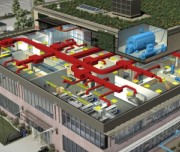Relevant Mandates and Rating Systems
| Mandates / Standards | Rating Systems |
|---|
Guiding Principles for Sustainable Federal Buildings
- The Principles require installation of building level meters for electricity, natural gas, and steam, with advanced meters as required by statute.
- Install building-level water meters to track and optimize indoor potable water use and detect leaks
- Outdoor water meters are recommended when irrigation systems are greater than 25,000 square feet.
Guiding Principles for Sustainable Federal Buildings
U.S. Department of Energy Federal Building Metering Guide: November 2014 Update
Defines which Federal buildings are appropriate to meter, provides metering prioritization recommendations, and requires a five-year metering implementation plan.
Presidential Memorandum: Federal Leadership on Energy Management
Encourages improved building performance and energy management by requiring Federal agencies to install building energy meters and submeters as required by section 543(e) of the National Energy Conservation Policy Act, as well as additional energy and water meters where cost-effective and appropriate.
Energy Independence and Security Act of 2007 (EISA)
Adds to the metering requirements of Energy Policy Act of 2005 by requiring that agencies establish energy benchmarks for their facilities’ portfolios, implement lifecycle cost-effective energy management projects through both commissioning and retrofits, and monitor and verify performance of the measures they implement.
Energy Policy Act of 2005 (EPAct 2005)
Federal buildings are required to have building-level metering of electricity according to Section 103 of the Energy Policy Act of 2005. “All Federal buildings shall, for the purposes of efficient use of energy and reduction in the cost of electricity used in such building be metered…to the maximum extent practicable.”
ANSI/ASHRAE/IES Standard 90.1-2013
Provides the minimum requirements for energy-efficient design of most buildings, except low-rise residential buildings in the United States. Requires measurement devices in new buildings to monitor electrical energy use for total electrical energy, HVAC systems, interior lighting, exterior lighting, and receptacle circuits. Metering must be monitored separately for total building usage and for each tenant, and automatically recorded a minimum of every 15 minutes and reported at least hourly, daily, monthly, and annually. Tenant level data must be made available for tenant use and information. Exceptions are made to buildings less than 25,000 square feet, individual tenant and residential spaces less than 10,000 square feet, dwelling units, and critical and equipment branches of NEC Article 517.
ANSI/ASHRAE/USGBC/IES/USGBC Standard 189.1-2014
Provides total building sustainability guidance for designing and operating high-performance green buildings. From site location, to energy use, to recycling, this standard sets the foundation for green buildings by addressing site sustainability, water use efficiency, energy efficiency, indoor environmental quality (IEQ), and the building’s impact on the atmosphere, materials and resources. Requires energy consumption measurement devices and subsystem measurement devices with remote communication capability to measure energy supply source use for all buildings according to prescribed energy source and system energy use thresholds. Measurement devices must collect energy data to a data acquisition system automatically at minimum daily, with hourly energy profiles. Consumption data must be stored in a data acquisition system for a minimum of 36 months and must be able to provide reports showing hourly, daily, monthly, and annual energy consumption.
New York City, New York
By January 1, 2025, submeters are required in all tenant spaces and must provide individual electricity usage to tenants in monthly submeter readings at minimum. Tenant spaces are defined as meeting the following criteria:(1) Exceed 10,000 gross square feet (gsf) on one or more floors of a covered facility let or sublet to the same person (2) Consists of a floor of a covered facility larger than 10,000 gross square feet (gsf) with tenant spaces let or sublet to two or more different persons.
San Francisco City and County, California
By January 1, 2014, tenants and landlords have the right to request submetering systems, are required in all new construction multi-tenant buildings, and during major tenant improvements in spaces that are larger than 2,500 square feet and buildings larger than 25,000 square feet.
State of Georgia
As part of the Georgia Water Stewardship Act, all new residential and commercial multi-unit spaces are required to be submetered and provide consumption reports to encourage conservation measures.
State of Washington
Buildings with gross conditioned floor areas over 50,000 square feet are required to measure, monitor, record, and display energy consumption data for each energy source and end-use category for effective energy management. Metering system must provide at least hourly data and must be fully integrated with a data storage and display system.

